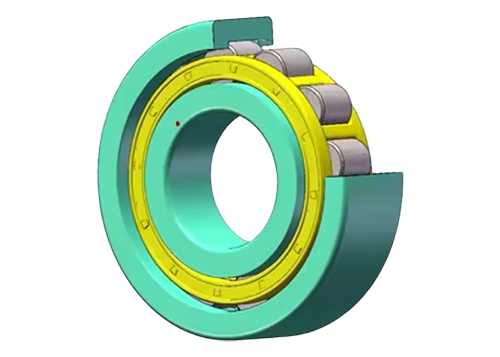
1. Detailed Structural Components
Cylindrical roller bearings consist of four fundamental components that
work in precise coordination:
Outer Ring
- Manufactured from high-grade chromium steel (typically GCr15 or SAE
52100) - Features hardened raceways with 58-64 HRC hardness
- May include ribbed designs for axial displacement control
Inner Ring
- Precision-ground to micron-level tolerances
- Often incorporates guide flanges for roller retention
- Heat-treated for optimal wear resistance
Roller Elements
- Cylindrical rollers with diameter/length ratios between 1:1 to 1:3
- Available in standard and full-complement configurations
- Surface finish of 0.05μm Ra for smooth operation
Cage Assemblies
- Common materials: pressed steel, brass, or polyamide
- Machined brass cages for high-speed applications
- Window-type designs for optimal lubrication flow
2. Performance Characteristics
Load Capacity Advantages
- 20-30% higher radial load capacity than equivalent ball bearings
- Dynamic load ratings ranging from 50kN to 1500kN
- Static load capacities up to 250% of dynamic ratings
Friction Optimization
- Coefficient of friction as low as 0.0011-0.0015
- Special roller crowning reduces edge stresses
- Advanced surface treatments minimize break-in wear
Speed Performance
- DN values (mm x rpm) exceeding 500,000
- Precision grades (P4, P2) available for ultra-high-speed operation
- Thermal stability up to 150°C continuous operation
3. Industrial Applications
Heavy Machinery
- Rolling mill stands (work and backup rolls)
- Large gearbox applications
- Mining equipment bearings
Power Generation
- Turbine generator sets
- Hydroelectric turbine bearings
- Wind turbine main shafts
Transportation Systems
- Railroad traction motors
- Heavy truck wheel ends
- Marine propulsion systems
4. Maintenance Considerations
Lubrication Requirements
- Grease: NLGI 2 or 3 with EP additives
- Oil: ISO VG 68-220 for circulating systems
- Re-lubrication intervals: 3,000-8,000 operating hours
Mounting Practices
- Proper interference fits (ISO tolerance classes)
- Induction heating for installation (max 120°C)
- Run-in procedures for new bearings
Failure Prevention
- Vibration monitoring thresholds
- Thermal imaging best practices
- Contamination control methods
5. Specialized Variants
Multi-Row Designs
- Double-row with axial load capacity
- Four-row for extreme radial loads
- Tandem arrangements for stiffness
Modified Geometries
- Logarithmic roller profiles
- Barrel-shaped rollers for misalignment
- Hybrid ceramic versions
Conclusion
Modern cylindrical roller bearings represent precision-engineered solutions for demanding industrial applications. Their optimized geometry and advanced materials deliver exceptional performance in load capacity, rotational accuracy, and service life. Proper selection and maintenance can significantly enhance machinery reliability and operational efficiency across multiple industries.